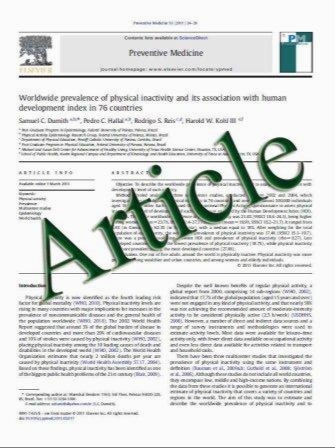The effect of exercise on pQCT parameters of bone structure and strength in postmenopausal women—a systematic review and meta-analysis of randomized controlled trials
- نوع فایل : کتاب
- زبان : انگلیسی
- مؤلف : I. Polidoulis & J. Beyene & A. M. Cheung
- چاپ و سال / کشور: 2011
Description
Summary Inconsistent study findings of exercise on areal bone density highlight the need to include parameters of bone geometry and volumetric bone density measurements. Using a systematic review and meta-analysis, we found a decrease in bone loss through the maintenance of cortical and trabecular volumetric bone mineral density (BMD). Studies with longer exercise durations and larger sample sizes are needed. Introduction Exercise has long been recommended to prevent age-related loss of bone mass in postmenopausal women. However, inconsistent study findings on the effect of exercise on BMD preservation have highlighted the importance of extending the evaluation of bone to include the parameters of bone geometry. We conducted both a systematic review and meta-analysis of the effects of exercise on bone geometry and volumetric BMD in postmenopausal women. Methods We searched MEDLINE, PubMed, and EMBASE from 1950 to April 2009 and included prospective, randomized controlled trials of healthy postmenopausal women where the intervention involved exercise or sport and outcomes included quantitative or peripheral quantitative computed tomography bone parameters. Outcome variables included: total volumetric BMD, cortical volumetric BMD (CvBMD), trabecular volumetric BMD (TrvBMD), total bone mineral content, cortical BMC, total bone area, cortical area, polar stress¨Cstrain index, and bone strength index. Results Six studies satisfied our inclusion and exclusion criteria. Lower extremity exercises resulted in small (،«0.9%) but significant improvements in TrvBMD of the distal tibia (p= 0.0006) and in CvBMD of the tibial shaft (p=0.0007). Studies with longer durations of exercise (12 months) and those in early postmenopausal women showed significant changes in CvBMD at the tibial shaft. Conclusions We conclude that exercise in postmenopausal women may decrease bone loss by maintaining cortical and trabecular volumetric BMD. To better understand the effect of exercise on bone geometric structure and strength, more studies of longer duration and larger sample sizes are needed.
Osteoporos Int DOI 10.1007/s00198-011-1734-7 Received: 29 December 2010 / Accepted: 22 June 2011


